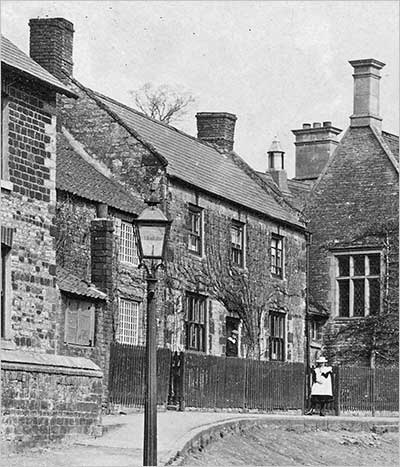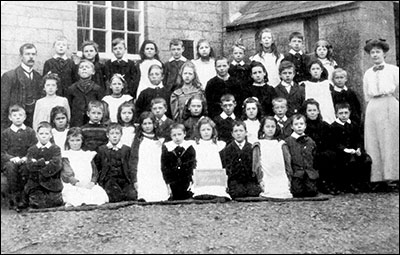|
George Talbutt was born in Little Harrowden in 1811 and his wife, Edith, came from Burton Latimer. Whellan’s Directory of 1849 records that he was baker. The bakehouse was a double fronted stone property dating from the early 18th century and stood next to the 17th century Church School in Church Street. The old school was built in 1622 and is now the home of Dr and Mrs K Padget. George died in 1887 at the age of 76 and, with his wife, Edith, had four children Eliza, George, James and William. Their son, George, was born in 1849, became a farmer and lived at Podington in Bedfordshire. James and William, however, remained in Burton Latimer and worked in the bakehouse with their father.
In the early 1900’s, George moved back to Burton Latimer with his wife and family and lived at 30 Church Street. A fine Georgian house, with a datestone of 1729, which was once owned by Mr James Osborne. Mr Osborne was a local farmer and churchwarden who lived in the house on the corner of High street and Church street, later the home of Dr and Mrs Kingsley.
Mr Osborne wanted to sell No 30 and offered it to the Talbutts for £300 but, unfortunately, they could not afford to buy. It was eventually sold to Mr Frederick Downing. The Talbutts then moved into Cranford Road and, for a number of years, Mrs Talbutt had a little shop on the corner of Bird Street. The family continued farming and had fields on the Wold and behind Cranford Road. Their daughter, Norah, was a familiar figure in the town. Twice a day she delivered milk, on foot, with a yoke across her shoulders and two churns. George died in 1936, aged 87.
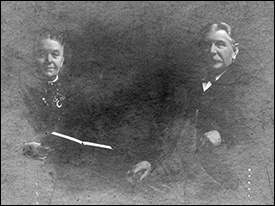 |
|
Mary and James Talbutt c1910
|
|
In 1884, James Talbutt married Mary Sharpe, daughter of William and Ann Sharpe, grocers, and in 1877 Mary’s sister, Deborah, married Charles Barlow and lived at the Yews in Kettering Road, now a Residential Home. Mr Barlow was a farmer and owned the iron stone quarries, he also had the grocery shop, now “Jolly Tots”, on the High Street opposite the War Memorial. Regular readers of this feature will also remember him being mentioned in last month’s feature on Burton Latimer Gas Works of which he was one of the original shareholders. Charles Barlow was a staunch Baptist and, in 1921, gave the piped organ in the Baptist church in memory of his wife, Deborah.James and Mary Talbutt had two children, George and Mabel. George became the headmaster of the Church school on the death of Joseph Boardman in 1923. There he remained until his own, sudden, death in 1938 aged 51.
|
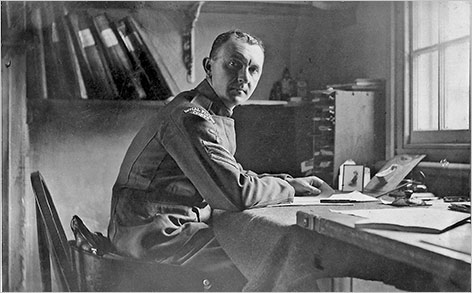 |
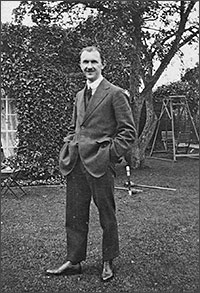 |
|
George Talbutt during his days in the Royal Flying Corps
|
George Talbutt,
Headmaster
|
His sister, Mabel, was born in 1888 and was a schoolteacher in Gretton until she returned to Burton Latimer, on the death of her father, in 1916. Mabel and her mother continued to live at the bakehouse until Mrs Talbutt’s death in 1927. Following James' death the business was run by James Capps and his son Leonard. The latter continued baking until the property was demolished, around 1969, together with the two adjoining cottages to make a garden for Dr Padget. The Talbutt family owned all the property from the Old Church School to the junction with Bakehouse Lane.
Mabel Talbutt at Gretton School in 1912.
Photograph courtesy of Gretton Local History Society
|
|
|
After the death of her mother, Mabel moved into 43 Church street which was the first house of a terrace of three and had been Burton’s first Post office. Joseph Moore was Post master there for 42 years until his death, in 1893 , aged 62. The next house in the terrace No 45, had been a Butchers when it was occupied by Mr Frederick Capps and, after that, a General Stores belonging to Mrs Carvell. No 47 was lived in by Mr and Mrs Harry Reed. In 1970 these three properties were converted into one house which is now the home of Mr and Mrs Christopher Pykett.
Miss Mabel Talbutt lived out her days in a bungalow in St Crispin Close. She died, in 1972, at the age of 84.
William Talbutt married Elizabeth Nichols in 1881 and their home was 44 High Street, the fine 18th century house, with it’s pillared porch, that stands back, behind, Burton Newsagent’s. Elizabeth’s father, William Nichols, was a stonemason who built the row of cottages, known as Nichol’s Row that once stood on, what is now, the car park in Church Street. Mr Nichols bought No 44 in the 1850’s.
William and
Elizabeth
Ta
lb
utt
had only one child,
Edith
, born in 1881.
William
died, in 1883, at the early age of 32 and his widow eventually re-married, in 1885, to
James
Blowfield
Nutt
who was a rate collector for the Parish Council. Together they had three daughters but, sadly,
Elizabeth
died in 1893 aged only 41.
Edith
,
Elizabeth
’s daughter from her first marriage, did not have a particularly happy life with her stepfather as he tended to favour his own daughters. He made
Edith
change her surname to “Nutt” however, after his death in 1910,
Edith
reverted to “Talbutt”. The little stone building that stands at the bottom of the front garden of
44 High Street
was used as an office where rents and rates would be collected. It has since been converted to a garage.
On May 23rd 1935 a local inquiry was held where Burton Latimer Urban Council was met by spirited opposition when its High street slum clearance proposals came before a Ministry of Health Inspector. The council proposed to demolish eight cottages, of which five were owned by Miss Edith Talbutt. These properties were known as Wallis’s Yard and stood on the site of the present Library and Health Centre. They were approached, in those days, by two, narrow, alleyways from that part of the High street known at High Causeway. One of the properties was a small factory where Wallis and Linnell had started manufacturing clothes.
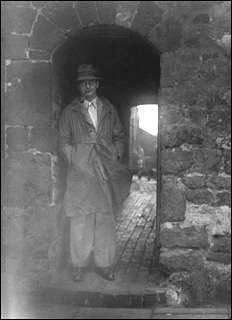 |
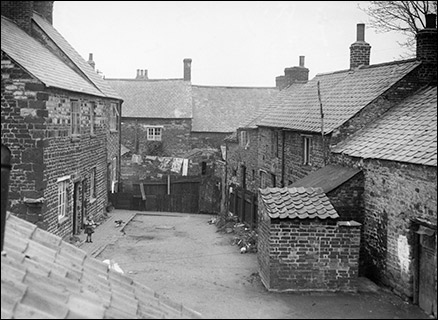 |
|
left - Mr G Borman at the entrance to Wallis' Yard
right - a general view of Wallis' Yard - the cottages in the background front the High Street
|
The Clerk to the Urban Council, Mr T H Harvey, said that his council considered the houses were unfit for human habitation and that they should be demolished by reason of “Disrepair, sanitary defects and being badly arranged”. None of the houses had a water closet reserved exclusively for its own use, none possessed a sink or bath, the water supply was by way of a stand pipe and the houses were huddled together and “Mostly dark and damp”
Mr G C Borman, the Council surveyor, commented that necessary repairs were not always carried out on the cottages for which weekly rents were 4/-, 6/- and 6/4d. (Between 20p and 32p in today’s money) In one house there was a pantry, measuring just 6ft 6” by 3ft, in which there was a copper and stove as well as the food.
The Council’s Medical Officer, Dr J M Mackintosh, referring to another cottage said “I should advise you when you visit this house to take care when going up the stairs because the room opening from them is so small and inconvenient that the bar of the bed hangs over the stairs so that you get a terrific knock as you go up. The bed in fact fills more than the room”. Dr A P Kingsley added that the conditions in the houses were unhygienic and “Not conducive to health or happiness of the inhabitants”.
It was reported that Miss Talbutt was of small independent means and she objected to the proposals as she was seriously concerned at the prospect of her income being diminished.
The Kettering Architect, Mr H R Surridge, considered the walls were in excellent condition and the roofs compared very favourably with that type of property. He considered that they were worth reconditioning and that five of the cottages could be converted into two houses.
Miss Talbutt said she was prepared to spend £120 to £130 on the reconditioning however, the inquiry later resulted in the offer of reconditioning not being accepted and a demolition order was eventually granted. Some of the resident’s were eventually re-housed, around 1937, when George Street was build. The rear of Wallis’s Yard was bordered by the former “Coles Boot Company” factory yard and at it’s junction with Pigotts Lane, Miss Talbutt had a pair of semi detached houses built. These were, in turn, demolished to make way for the Health Centre and Library car park around 1970.
I well remember Miss Talbutt as a little, elderly lady; wearing a brown raincoat and felt hat and riding a tall bicycle around the Town. She would even cycle over to Little Harrowden to collect rents and would record her transactions with a neat hand. When her tenants complained of the lack of a bath she may well have said “Well, even I don’t have a bathroom”. This was perfectly true, 44 High Street Burton Latimer, with all its spacious rooms, did not boast a bathroom!
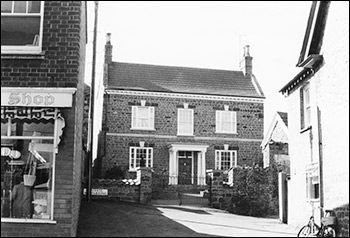 |
| 44 High Street, in a photo taken in 1978 |
|
Miss
Edith
Talbutt
died in 1960, at the age of 78. In her will she left £11,000 which included the value of all her remaining properties in various parts of the town. Her step-sister Clarissa Mabel Nutt, until then a governess living at Salisbury, placed
44 High Street
up for sale at the asking price of £1,750. In 1965, after
Denton
’s Farmhouse on the High street was demolished and
Churchill Way
constructed, the public footpath from Isham was re-directed. The part of the pathway that went by
44 High Street
, known as Barber’s Jitty, was incorporated into its garden. |
